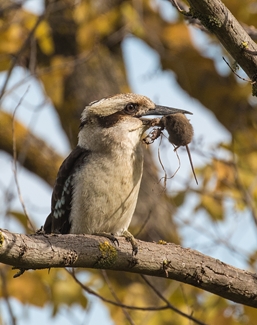The annual whale migration has started along our coastline.
Some sightings have been made during the past month. A pod of Humpbacks were sighted a few hundred metres offshore between Wye River and Lorne and a Southern Right Whale and calf were seen just near the Lorne pier (separate photo by Mandy Watson, DELWP, Warrnambool).

A pair of Wedge-tailed Eagles is regularly seen flying and gliding along the Torquay Road, just past the roundabout. They sometimes fly quite low, and I have seen them being harassed by groups of smaller birds, mostly magpies. The nesting season for wedge-tails is from June to October and they may be preparing to breed.
Aaron Ledden (Parks Victoria) reported that on two occasions he has seen a pair of White-bellied Sea Eagles in the section of coast between Big Hill and Lorne around the Cathedral Rock area. Both were adults birds and were actively circling for fish.

White-bellied Sea Eagle (Birdlife Australia)
In early June, a public presentation was organised by the Kangaroo Advisory Group. The talk, given by Guest Speaker Dr Rod van der Ree, was titled: Solving the Wildlife, Roads and Traffic Conflict. The talk focused on the impact on wildlife and the environment of multi-laned, high volume freeways and the many highway systems which connect to them. This problem is worldwide, divides range areas and in the process takes an enormous toll on the animal population.
Some solutions have been very effective. For example, on the Hume Hwy overpasses covered with vegetation provide safe passage for kangaroos, koalas and other animals. High cable bridges provide access for ringtail possums, brushtail possums, pygmy possums and even a lace monitor. Glider poles have been used by sugar gliders.
On the Calder freeway underpasses and fencing allow safe movement for koalas, wallabies, kangaroos and brush-tailed phascogales. Cameras placed at either end provide evidence that animals will use these safe pathways.
While driving along Dickins Rd between the Anglesea Rd and Ghazeepore Rd near Freshwater Creek, I noticed several wood ducks were resting close to one of the farm dams, and among the group were two banded lapwings. About 12 months ago a pair was seen in almost the same spot.
Robyn Caddy from Aireys Inlet has provided the following account of kookaburra behaviour.
‘I was interested to read, in the Angair June newsletter, Penny’s account of watching two kookaburras with a rat. We also have a house at Aireys Inlet, and in January, I went outside when I heard a young kookaburra rather insistently begging for food in our front yard. The sight I saw made me call other members of the family outside to watch. The nagging youngster was sitting near an adult who was dealing with a large rat. As we watched, the kookaburra repeatedly bashed the rat on the branch, sometimes coming close to toppling over, and then worked it from the head to the hindquarters through its beak and back again, rather like tenderising! Firstly, I wondered how on earth the youngster was going to eat the rat if it was passed on by the adult, and then I thought perhaps the adult might swallow it, allow the digestive juices to do their work and then give it to the youngster at a later date.

Kookaburra
Photo courtesy of Geoff Park Natural Newstead
The rat was obviously dead, however the adult spent a long time “working” the huge meal until finally throwing its head back, and with the head of the rat held firmly in its beak, and the body straight out behind, began to swallow it whole until finally the tail disappeared. It was obviously quite an effort, the kookaburra was holding its head high in an extended manner and you could see the thickening of the kookaburra’s throat area as the rat disappeared. It was definitely a common rat. The adult took a couple of minutes to recover, moving its head up and down, and then finally flew off, followed by perhaps a very disappointed youngster!
We have a family of kookaburras who live in the area around our block, and have a nesting hollow in one of our trees. Prior to this I have only observed them taking lizards and small mice.’
Peter Crowcroft from GORCC shares with us his experience of fox and possum interaction: ‘It had been a completely silent night at Moggs Creek picnic area. We were about to leave when I heard a scream echo through the bush. I went to investigate and there were sounds of a scuffle, branches moving around, and finally a Brushtail Possum climbed up a tree, with a fox looking up from below. A great escape!
Kaye Traynor